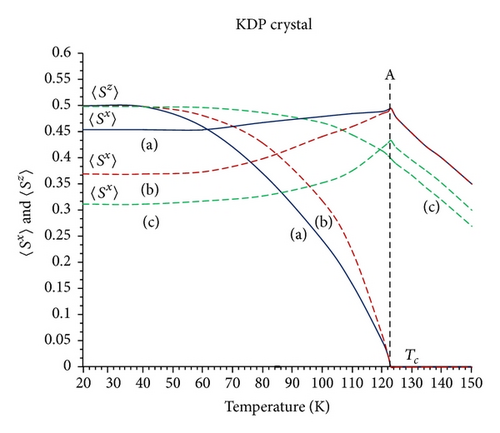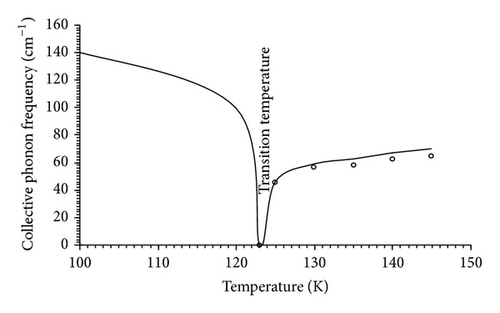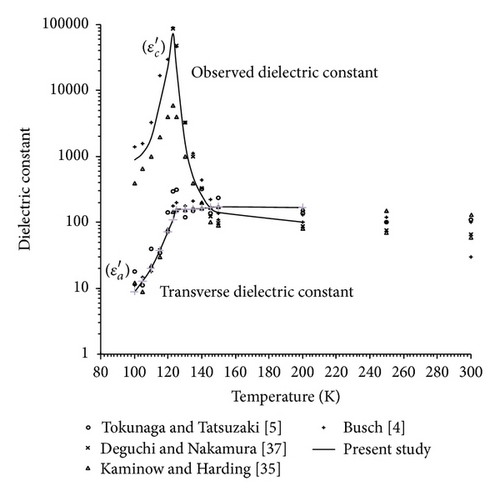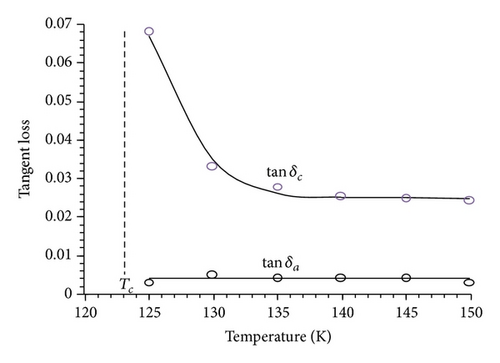Study of Dielectric Properties and Ultrasonic Attenuation in KDP-Type Ferroelectrics
Abstract
The soft mode dynamical model has been used to study dielectric properties and ultrasonic attenuation in KDP-type ferroelectric crystals. The model Hamiltonian proposed by Blinc and Zeks has been modified by considering lattice anharmonicity up to fourth-order. The correlations appearing in the dynamical equation have been evaluated using double-time thermal retarded Green’s functions method and Dyson’s equation. Without any decoupling, the higher order correlations, appearing in the dynamical equation, have been evaluated using the renormalized Hamiltonian. The expressions for collective frequencies, width, dielectric constant, ultrasonic attenuation, and tangent loss have been calculated. The dielectric properties and ultrasonic attenuation strongly depend on the relaxational mode behavior of stochastic motion of H2PO4 group in KDP-type ferroelectrics. By fitting model values of physical quantities, the temperature dependence of and for different value of four-body coupling coefficient and dielectric constant and loss tangent has been calculated. The calculated and observed results have been found in good agreement.
1. Introduction
The oscillations of atoms in solids are responsible for different characteristics, such as specific heat, optical, dielectric, and electrical properties. The anharmonicity in solids is responsible for existence of thermal expansion, temperature variation of elastic constants, lattice thermal conductivity, deviation of specific heat from Dulong-Petit law at high temperature, existence of ferroelectricity in certain materials, and so forth. Many attempts have been made theoretically and experimentally to find the explanation of these phenomena in terms of anharmonicity. Extensive reviews [1, 2] are available discussing the contribution of anharmonicity to various properties of crystals.
In order-disorder type ferroelectrics, as Potassium Dihydrogen Phosphate (KH2PO4), the transition is associated with the tunneling of proton through a barrier between two positions of minimum potential energy in double well potential in the hydrogen bond at the transition temperature [3]. Busch [4] was the first to show that KDP (KH2PO4) exhibits a phase transition at low temperature. KDP is prototype of a family of crystals with bridging hydrogen bonds and its physical properties have been extensively studied [3, 5–10].
Kaminow and Damen [11] first observed the soft mode associated with the ferroelectric phase transition of the KDP-type crystal at 122.3 K by measuring the low frequency Raman scattering in x(yx)y configuration. Since then B2(z) soft mode which is connected to the susceptibility along the crystalline c-axis through the Lyddane-Sachs-Teller relation [12] has been extensively studied by Scott [13] and interpreted using the pseudospin model [14–16] and its modifications in [3, 17]. In these theories, such a particular mode of proton motions along hydrogen bonds in a-b plane is coupled to other ion modes, bearing an electrical dipole moment along c-axis is considered to play an essential role for the ferroelectric transition, and therefore little attention has been paid to the modes other than B2(z) soft mode. In KDP crystal, however, there are four tunneling protons in a primitive unit cell of the paraelectric (hereafter referred to as PE) phase and consequently four normal modes are belonging to B2(z), a doubly degenerate E(x, y), and A2 modes [18]. E(x, y) mode, which is both infrared and Raman active, provides valuable information, because this mode and B2(z) mode reflect the nature of collective proton motion which triggers the phase transition, and, moreover, in contrast to B2(z), it is directly related to the polarization along the crystalline a-axis.
At first, Pak [19] employed Green’s function methods in the order-disorder type ferroelectrics and, however, did not consider the anharmonic interactions. The phonon anharmonic interactions have been found very important in explaining dielectric, thermal, and scattering properties of solids by many authors [6–9, 20, 21] in the past. Pak’s theory was further developed by Ramakrishnan and Tanaka [22], who calculated the excitation spectrum of the system but did not consider the anharmonic interactions. Their attempt, however, established the superiority of Green’s function method over the other methods. Ganguli et al. [23] modified Ramakrishnan and Tanaka theory by considering anharmonic interaction. Their treatment explains many features of order-disorder ferroelectrics. However, due to insufficient treatment of anharmonic interactions, they could not explain quantitatively good results and could not describe some very interesting properties, like dielectric properties, ultrasonic attenuation, relaxation rate, and so forth.
In the present study, the four-particle cluster model Hamiltonian with the phonon anharmonicity up to fourth-order has been taken to theoretical study of dielectric properties and ultrasonic attenuation in KDP-type crystals, using double time Green’s functions method and Dyson’s equation. Proton Green’s function and phonon Green’s function have been solved for the collective system. Expressions for collective mode frequency shifts, widths, transition (Curie) temperature, and the expectation value of the proton collective mode components at site q (,) have been derived and discussed in KDP-type crystals. By fitting model values of physical quantities, the temperature dependence of and for different value of four-body coupling, dielectric constant, and loss tangent has been calculated. The calculated and observed results have been found in good agreement.
2. The Model Hamiltonian and Green’s Function
2.1. Collective Proton Wave Width and Shift
2.2. Collective Phonon Half Width and Mode Frequency Shift
2.3. Order Parameter Values of , , and
2.4. Dielectric Constant and Tangent Loss
2.5. Ultrasonic Attenuation
2.6. Transition Temperature
3. Comparison with Experiments and Discussion
3.1. Numerical Calculations
The parameters in our calculation are listed in Table 1. The calculated values of and for KDP-type crystals for different values of four-body coupling coefficient (J′), collective phonon mode frequency , transverse dielectric constant {εa(o)}, observed dielectric constant {εc(o)}, and tangent loss along a-axis (tanδa) and c-axis (tanδc) for KDP-type crystals are listed in Tables 2 and 3. Their variations with temperature are shown in Figures 1–4.
| Ω (cm−1) | J (cm−1) | J′ (cm−1) | Vik (cm−1) | ωk (cm−1) | μ × 1018 (cgs) | Tc (K) | V/kTc |
|---|---|---|---|---|---|---|---|
| 82 | 334 | 440 | 25.56 | 153 | 1.8 | 123 | 0.299 |
|
|
|
|||||
|---|---|---|---|---|---|---|
| Temperature (K) | J′ = J/3 | J′ = 4J/3 | J′ = 7J/3 | J′ = J/3 | J′ = 4J/3 | J′ = 7J/3 |
| Present study | Present study | |||||
| 20 | 0.500 | 0.499 | 0.499 | 0.454 | 0.369 | 0.311 |
| 40 | 0.498 | 0.499 | 0.499 | 0.455 | 0.369 | 0.311 |
| 60 | 0.459 | 0.481 | 0.498 | 0.460 | 0.376 | 0.312 |
| 80 | 0.257 | 0.278 | 0.487 | 0.482 | 0.446 | 0.317 |
| 100 | 0.137 | 0.143 | 0.454 | 0.489 | 0.479 | 0.332 |
| 120 | 0.102 | 0.104 | 0.409 | 0.490 | 0.485 | 0.354 |
| 122 | 0.100 | 0.100 | 0.403 | 0.491 | 0.486 | 0.357 |
| 123 | 0.000 | 0.000 | 0.400 | 0.492 | 0.492 | 0.358 |
| 125 | 0.000 | 0.000 | 0.398 | 0.484 | 0.484 | 0.449 |
| 130 | 0.000 | 0.000 | 0.389 | 0.468 | 0.468 | 0.457 |
| 135 | 0.000 | 0.000 | 0.373 | 0.446 | 0.446 | 0.443 |
| 140 | 0.000 | 0.000 | 0.352 | 0.426 | 0.426 | 0.436 |
| 145 | 0.000 | 0.000 | 0.320 | 0.408 | 0.408 | 0.410 |
| 150 | 0.000 | 0.000 | 0.300 | 0.396 | 0.396 | 0.392 |
| Temperature (K) | Collective phonon mode frequency (cm−1) (present study) | Transverse dielectric constant εa(0) (present study) | Observed dielectric constant εc(0) (present study) | Loss tangent along the a-axis (tanδa) (present study) | Loss tangent along the c-axis (tanδc) (present study) |
|---|---|---|---|---|---|
| 125 | 45.65 | 63 | 35741 | 0.004 | 0.067 |
| 130 | 57.04 | 62 | 6144 | 0.00398 | 0.035 |
| 135 | 58.69 | 61 | 2286 | 0.00397 | 0.0261 |
| 140 | 63.04 | 60 | 874 | 0.00396 | 0.0255 |
| 145 | 65.91 | 59 | 486 | 0.00365 | 0.0250 |




3.2. Temperature Dependence of and for KDP-Type Crystal for Different Values of J′
Using Blinc-de Gennes model parameter values for KDP-type ferroelectrics crystals as given by Ganguli et al. [23], putting these values into (27) and (28), we have calculated temperature dependence of and for KDP-type crystal for different values of J′, and variation is shown in Figure 1.
In Figure 1, the curve (a) is the case of J′ = J/3 < 4J/3, curve (b) is J′ = 4J/3 < 7J/3, and curve (c) is J′ = 7J/3 > 4J/3. In curves (a) and (b) the value of increases to the saturated value 0.5 from zero, when temperature decreases from transition temperature. That is the case of second-order phase transition. But in curve (c) the change of with the temperature starts from a nonzero value at point “A”; that is to say, when temperature decreases increases to the saturation value from the finite value of . This is the case of first-order phase transition. The temperature at point “A” is transition temperature, and the value of at “A” is the discontinuity of . The value of decreases when temperature decreases in the ferroelectric phase. On the other hand, in PE phase the value of decreases when temperature increases from transition temperature.
3.3. Temperature Dependence of Collective Phonon Mode Frequency in PE Phase
Using (23) and (41) and model parameters values from Table 1, the temperature variation of collective phonon mode frequency in PE phase is shown in Figure 2. In the PE phase the temperature dependence of normalized collective phonon frequency enables one to calculate the transition temperature (44), as well as effective exchange coupling constant (43), which increases due to proton-phonon coupling and decreases due to anharmonic interactions. By fitting model values of physical quantities, temperature dependence of collective phonon mode frequency has been calculated which compares well with experimental results of Baumgartner [32] and Choi and Lockwood [33].
3.4. Temperature Dependence of Dielectric Constant
Putting calculated values for different temperature into (32) we obtain dielectric constant for KDP-type crystals. mode corresponds to transverse E(x, y) mode, which is responsible for the observed transverse dielectric properties of KDP. In the simplest approximation can be written (), where K1 and K2 are temperature independent parameters. The results for transverse dielectric constant obtained from the integrated intensity of Raman spectroscopy [34] and those measured by Busch [4] and Kaminow and Harding [35] are shown in Figure 3, together with the theoretical results of Havlin et al. [36]. This indicates that low frequency {E(x, y) mode} is closely related to the macroscopic dielectric constant . This also suggests that the E-mode Raman spectrum originates neither from the second-order Raman scattering nor from the density of states due to the local disorder above Tc but from one of the collective modes at the centre of the Brillouin zone. It should be mentioned here that the low frequency E-mode continuum appears also in a deuterated KDP (DKDP), although the intensity is about one-third of that of KDP, which indicates the possibility that the spectrum is due to the hydrogen collective motion. Using (23) for mode, it can be seen that the E-mode collective hydrogen motion has characteristics damping factor which slowly increases as the temperature approaches Tc, while for that of soft mode the damping factor slowly decreases down to a finite value, which agrees with the observations of Kaminow and Damen [11].
The present results agree with the behaviour of the observed E-mode Raman spectrum in the following aspects: (i) does not change appreciably as T → Tc in PE phase, (ii) is weakly dependent on temperature, and (iii) because of the factor () in the numerator of (31), the susceptibility derived changes the corresponding spectrum from a simple overdamped form to a more flat one, like the E-mode Raman spectrum of KH2PO4 [27].
There are actually, however, many cases in which takes a minimum of finite value at T = Tc being neither zero as in Mason’s theory nor maximum as in Hill and Ichiki theory.
3.5. Temperature Dependence of Tangent Loss
The tangent loss is associated with damping parameter (25). Damping can be understood as the creation of a virtual polarization mode excited by the transverse electromagnetic radiation and its subsequent decay into the real phonons by scattering from crystal defects, higher order phonon anharmonicities, and so forth. At higher temperature the loss deviates from the Curie-Weiss type behaviour and increases linearly with temperature. This behaviour suggests that at higher temperatures the phonon anharmonicity contributes significantly to the observed loss.
The calculated values of tangent loss from (33) and (34) and experimental result of Kaminow and Harding [35] are shown in Figure 4 and given in Table 3. The loss was calculated at 9.2 GHz because experimental data is available only at that frequency range. The theoretical results of the present study are in good agreement with experimental results of Kaminow and Harding [35]. The temperature dependence of loss does not appear to be exponential. Thus, third- and fourth-order anharmonicity may be responsible for the observed behaviour of loss tangent. In the microwave frequency rage, an increase in frequency is followed by an increase in transverse and longitudinal dielectric loss tangent. The loss decreases with increase in temperature for KDP-type crystals, in their PE phase. This shows Curie-Weiss type behaviour of the dielectric loss tangent.
In this paper the four-particle cluster model Hamiltonian with the anharmonic contributions up to fourth-order has been taken into consideration in study of dielectric properties and ultrasonic attenuation in KDP-type ferroelectric crystals. Using double time thermal Green’s function method and Dyson’s equation the collective mode frequencies and widths have been calculated. These parameters lead to the expressions for the dielectric constant and loss tangent. The observed dielectric properties have been explained in terms of present study. The expressions for dielectric constant and loss tangent have been derived and compared with the experimental results. Using Blinc-de Gennes model parameter values given by Ganguli et al. [23] we have calculated temperature variations of these quantities for KDP- type crystals. It is observed that these results are in good agreement with each other and with the results obtained by other methods. The present results reduce to the results of others [22, 23, 40] if the width and shift are neglected. Only Ganguli et al. [23] modified the Ramakrishnan and Tanaka theory by considering anharmonic interaction. Their treatment explains many features of order-disorder ferroelectrics. However, due to insufficient treatment of anharmonic interactions, they could not obtain quantitatively good results and could not describe some very interesting properties, like dielectric properties, acoustic attenuation, and so forth.
Thus, from the present study, it is concluded that the consideration of four-cluster Hamiltonian along with the third- and fourth-order anharmonicities for the KDP-type ferroelectrics leads to the renormalization and stabilization of the relaxational soft mode and the renormalization of the pseudospin exchange interaction constant. The decoupling of the correlations appearing in the dynamical equation after applying Dyson’s equation results in shift in frequency and facilitates the calculation of damping parameter, which is related to the loss tangent. The anomalous behaviour in order-disorder KDP-type ferroelectrics finds explanation by the consideration of collective proton-phonon interaction and third- and fourth-order anharmonicities in the four-particle cluster Hamiltonian. The dielectric properties and ultrasonic attenuation strongly depend on the relaxational mode behaviour of stochastic motion of H2PO4 group in KDP-type ferroelectrics.
Competing Interests
The authors declare that there is no conflict of interests regarding the publication of this paper.




